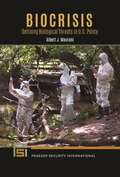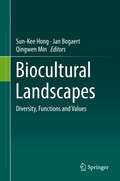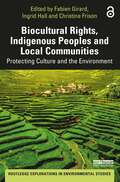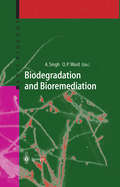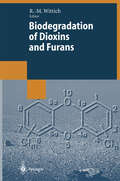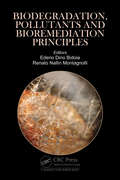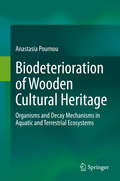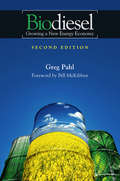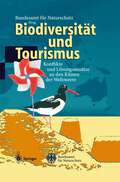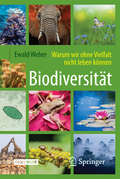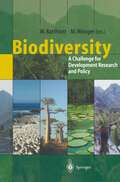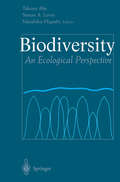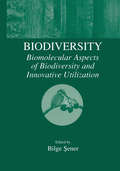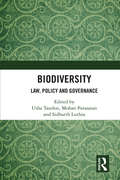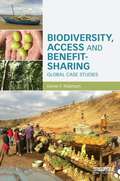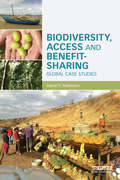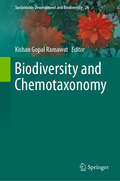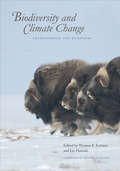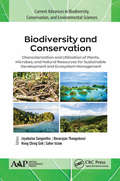- Table View
- List View
Biocrisis: Defining Biological Threats in U.S. Policy (Praeger Security International)
by Albert J. MauroniThis book examines the recent intersection of national security and public health regarding biological threats to the U.S. populace and proposes improvements to the executive and legislative development of U.S. policy addressing biological threat mitigation.Over the last 20 years, the national security community has engaged with disease-related issues that have traditionally been the scope of public health agencies. The federal government's response has been to create a single national biodefense strategy, which has been largely ineffective in improving conditions due to poor terminology, a lack of leadership, and a failure to assess government programs.Applying a public policy framework, Albert J. Mauroni examines how the government addresses biological threats-including disease prevention, bioterrorism response, military biodefense, biosurety, and agricultural biosecurity and food safety. He proposes a new approach to countering biological threats, arguing that lead agencies should focus on implementing discrete portfolios with annual assessments against clear and achievable objectives.
Biocrisis: Defining Biological Threats in U.S. Policy (Praeger Security International)
by Albert J. MauroniThis book examines the recent intersection of national security and public health regarding biological threats to the U.S. populace and proposes improvements to the executive and legislative development of U.S. policy addressing biological threat mitigation.Over the last 20 years, the national security community has engaged with disease-related issues that have traditionally been the scope of public health agencies. The federal government's response has been to create a single national biodefense strategy, which has been largely ineffective in improving conditions due to poor terminology, a lack of leadership, and a failure to assess government programs.Applying a public policy framework, Albert J. Mauroni examines how the government addresses biological threats-including disease prevention, bioterrorism response, military biodefense, biosurety, and agricultural biosecurity and food safety. He proposes a new approach to countering biological threats, arguing that lead agencies should focus on implementing discrete portfolios with annual assessments against clear and achievable objectives.
Biocultural Landscapes: Diversity, Functions and Values
by Sun-Kee Hong Jan Bogaert Qingwen MinThis book is devoted to the cultural and biological dimensions and values of landscapes, linking the concepts of biodiversity, landscape and culture and presenting an essential approach for landscape analysis, interpretation and sustainable dynamics.Early chapters explore the concepts and values of biocultural landscapes, before addressing the methodology to identify the relationship between biological and cultural diversity. The volume continuous with a series of case studies and with an exploration of the key role of biocultural diversity in contemporary landscape ecology.Readers will learn the importance of landscapes for different fields of natural and human sciences and are confronted to the trans-disciplinary nature of the landscape concept itself. A hierarchical approach to landscapes, in which they are composed of interacting (eco)systems, is shown to be essential in recognizing their emergent properties.In this work, the biocultural values of landscapes are explored through their diversity in geographical scopes, methodological approaches and conceptual assumptions. Authors from Asia, Europe and North-America present diverse research experiences and views on biocultural landscapes, their pattern, conservation and management.Landscape ecologists will find this work particularly appealing, as well as anyone with an interest in sustainable landscape development, nature conservation or cultural heritage management.This volume is the outcome of a symposium on “Biodiversity in Cultural Landscapes”, organized in the framework of the 8th IALE World Congress, held in Beijing in 2011.
Biocultural Rights, Indigenous Peoples and Local Communities: Protecting Culture and the Environment (Routledge Explorations in Environmental Studies)
by Fabien GirardThis volume presents a comprehensive overview of biocultural rights, examining how we can promote the role of indigenous peoples and local communities as environmental stewards and how we can ensure that their ways of life are protected. With Biocultural Community Protocols (BCPs) or Community Protocols (CPs) being increasingly seen as a powerful way of tackling this immense challenge, this book investigates these new instruments and considers the lessons that can be learnt about the situation of indigenous peoples and local communities. It opens with theoretical insights which provide the reader with foundational concepts such as biocultural diversity, biocultural rights and community rule-making. In Part Two, the book moves on to community protocols within the Access Benefit Sharing (ABS) context, while taking a glimpse into the nature and role of community protocols beyond issues of access to genetic resources and traditional knowledge. A thorough review of specific cases drawn from field-based research around the world is presented in this part. Comprehensive chapters also explore the negotiation process and raise stimulating questions about the role of international brokers and organizations and the way they can use BCPs/CPs as disciplinary tools for national and regional planning or to serve powerful institutional interests. Finally, the third part of the book considers whether BCPs/CPs, notably through their emphasis on "stewardship of nature" and "tradition", can be seen as problematic arrangements that constrain indigenous peoples within the Western imagination, without any hope of them reconstructing their identities according to their own visions, or whether they can be seen as political tools and representational strategies used by indigenous peoples in their struggle for greater rights to their land, territories and resources, and for more political space. This volume will be of great interest to students and scholars of environmental law, indigenous peoples, biodiversity conservation and environmental anthropology. It will also be of great use to professionals and policymakers involved in environmental management and the protection of indigenous rights.
Biocultural Rights, Indigenous Peoples and Local Communities: Protecting Culture and the Environment (Routledge Explorations in Environmental Studies)
by Fabien Girard Ingrid Hall Christine FrisonThis volume presents a comprehensive overview of biocultural rights, examining how we can promote the role of indigenous peoples and local communities as environmental stewards and how we can ensure that their ways of life are protected. With Biocultural Community Protocols (BCPs) or Community Protocols (CPs) being increasingly seen as a powerful way of tackling this immense challenge, this book investigates these new instruments and considers the lessons that can be learnt about the situation of indigenous peoples and local communities. It opens with theoretical insights which provide the reader with foundational concepts such as biocultural diversity, biocultural rights and community rule-making. In Part Two, the book moves on to community protocols within the Access Benefit Sharing (ABS) context, while taking a glimpse into the nature and role of community protocols beyond issues of access to genetic resources and traditional knowledge. A thorough review of specific cases drawn from field-based research around the world is presented in this part. Comprehensive chapters also explore the negotiation process and raise stimulating questions about the role of international brokers and organizations and the way they can use BCPs/CPs as disciplinary tools for national and regional planning or to serve powerful institutional interests. Finally, the third part of the book considers whether BCPs/CPs, notably through their emphasis on "stewardship of nature" and "tradition", can be seen as problematic arrangements that constrain indigenous peoples within the Western imagination, without any hope of them reconstructing their identities according to their own visions, or whether they can be seen as political tools and representational strategies used by indigenous peoples in their struggle for greater rights to their land, territories and resources, and for more political space. This volume will be of great interest to students and scholars of environmental law, indigenous peoples, biodiversity conservation and environmental anthropology. It will also be of great use to professionals and policymakers involved in environmental management and the protection of indigenous rights.
Biodegradation and Bioremediation (Soil Biology #2)
by Dr Ajay SinghIn this volume, experts from universities, government labs and industry share their findings on the microbiological, biochemical and molecular aspects of biodegradation and bioremediation. The text covers numerous topics, including: bioavailability, biodegradation of various pollutants, microbial community dynamics, properties and engineering of important biocatalysts, and methods for monitoring bioremediation processes. Microbial processes are environmentally compatible and can be integrated with non-biological processes to detoxify, degrade and immobilize environmental contaminants.
Biodegradation, Pollutants and Bioremediation Principles
by Ederio Dino BidoiaThis book presents a broad compendium of biodegradation research and discussions on the most up-to-date bioremediation strategies. The most relevant microbiological, biochemical and genetic concepts are presented alongside the fundamentals of bioremediation. The topics include: a wide variety of contaminant impacts evaluation, key methodologies required to measure biodegradation and propose new bioremediation protocols, as well as the handling of microbial communities related to such processes. The selected collaborating authors are renowned for their microbiology expertise and will provide an in-depth reference for students and specialists. The contents provide a valuable source of information for researchers, professionals, and policy makers alike.
Biodegradation, Pollutants and Bioremediation Principles
by Ederio Dino Bidoia Renato Nallin MontagnolliThis book presents a broad compendium of biodegradation research and discussions on the most up-to-date bioremediation strategies. The most relevant microbiological, biochemical and genetic concepts are presented alongside the fundamentals of bioremediation. The topics include: a wide variety of contaminant impacts evaluation, key methodologies required to measure biodegradation and propose new bioremediation protocols, as well as the handling of microbial communities related to such processes. The selected collaborating authors are renowned for their microbiology expertise and will provide an in-depth reference for students and specialists. The contents provide a valuable source of information for researchers, professionals, and policy makers alike.
Biodeterioration of Wooden Cultural Heritage: Organisms and Decay Mechanisms in Aquatic and Terrestrial Ecosystems
by Anastasia PournouSince prehistoric times and throughout the course of human evolution, wood has been an integral part of all civilizations. Wooden Cultural Heritage can be found worldwide, providing valuable information on the social and economic context of human history. Nonetheless, as a natural cellulosic material, wood shows low resistance to biodeterioration and thus wooden Cultural Heritage often fails to escape decomposition in both aquatic and terrestrial ecosystems. This book provides a comprehensive overview on the biodeterioration of wooden Cultural Heritage and describes the decay mechanisms of key organisms and microorganisms encountered in aquatic and terrestrial ecosystems. Cultural Heritage professionals, researchers and academics may explore within this book the associations between deteriogens, habitats and decay, which will assist them to understand wood biodeterioration and design effective prevention, mitigation and remediation strategies. The book presents case studies around the world to demonstrate the impact of biogenic deterioration on wooden Cultural Heritage and illustrates mechanisms and patterns in order to be a useful handbook of decay diagnosis.Lastly, by adopting a holistic approach to wood decay, basic concepts of wood technology, ecology, and deteriogens' biology are introduced, permitting readers of different scientific backgrounds to easily comprehend wood biodeterioration.
Biodiesel: Growing a New Energy Economy, 2nd Edition
by Greg Pahl Bill McKibbenFor anyone who is trying to keep up with the extremely rapid developments in the biodiesel industry, the second edition of Biodiesel: Growing a New Energy Economy is an invaluable aid. The breathtaking speed with which biodiesel has gained acceptance in the marketplace in the past few years has been exceeded only by the proliferation of biodiesel production facilities around the United States--and the world--only to confront new social and environmental challenges and criticisms. The international survey of the biodiesel industry has been expanded from 40 to more than 80 countries, reflecting the spectacular growth of the industry around the world. This section also tracks the dramatic shifts in the fortunes of the industry that have taken place in some of these nations. The detailed chapters that cover the industry in the United States have also been substantially rewritten to keep abreast of its many new developments and explosive domestic growth. An expanded section on small-scale, local biodiesel production has been added to better represent this small but growing part of the industry. Another new section has been added to more fully explore the increasingly controversial issues of deforestation and food versus fuel, as well as GMO crops. The second edition concludes with updated views on where the industry is headed in the years to come from some of its key players.
Biodiversität und Tourismus: Konflikte und Lösungsansätze an den Küsten der Weltmeere
by I. DahmsDie "Konvention über die biologische Vielfalt", ein Ergebnis der Konferenz der Vereinten Nationen für Umwelt und Entwicklung (UNCED) 1992 in Rio de Janeiro, hat die verschiedenen internationalen Naturschutzbemühungen erstmals auf eine umfassende, globale Grundlage gestellt. Die unterzeichnenden Staaten verpflichten sich die biologische Vielfalt der Erde zu schützen und gleichzeitig nachhaltig zu nutzen. Eine der Nutzungen, die Auswirkungen auf die globale Biodiversität haben, ist der Tourismus. Hier werden am Beispiel vorwiegend europäischer Küstenregionen, den Hauptzentren des Tourismus, Konflikte zwischen Naturschutz und touristischer Nutzung erläutert und Lösungsansätze zur Minimierung von Konflikten vorgestellt.
Biodiversität - Warum wir ohne Vielfalt nicht leben können
by Ewald WeberEine Einladung in die Biologie der Vielfalt Dieses Buch berichtet über ein ebenso spannendes wie aktuelles Thema an der Schnittstelle zwischen naturwissenschaftlicher Grundlagenforschung und globaler gesellschaftlicher Herausforderung: die Biodiversität. Drei Ebenen kommen hier zusammen: die Vielfalt der Arten in einem Lebensraum, die Vielfalt der Ökosysteme und Lebensräume selbst und die Vielfalt der Gene in den Lebewesen. Der Autor, Biologe und selbst in der Biodiversitätsforschung tätig, nimmt Sie mit auf eine aufregende Entdeckungsreise durch diese mannigfach vernetzte Welt. In leicht verständlicher Sprache und mit vielen anschaulichen Beispielen erklärt er Zusammenhänge und Hintergründe. Wie ist Biodiversität eigentlich definiert, und mit welchen Techniken wird sie erfasst? Wie ist die immense Artenvielfalt auf der Erde entstanden, und wie entwickelt sie sich weiter? Welchen Nutzen hat die Biodiversität auf den verschiedenen Ebenen? In welchem Maße ist die Vielfalt der Arten und Lebensräume heute bedroht, und wie kann man diesem Trend entgegenwirken? Solche und ähnliche Fragen beantwortet dieses Buch, in dessen breitem Themenbogen sich die Vielfalt seines Gegenstands wiederspiegelt. Tauchen Sie ein in die faszinierende Welt der Biodiversität! Der AutorEwald Weber ist Biologe und Sachbuchautor. Er lehrt und forscht an der Universität Potsdam mit Schwerpunkt Biodiversität. Sein Anliegen als Autor ist das Vermitteln von wissenschaftlichen Zusammenhängen und von Naturgeschichte im weitesten Sinn.
Biodiversity: A Challenge for Development Research and Policy
by N. BiedingerBiodiversity, sometimes simply understood as "diversity of species", is a specific quality of life on our planet, the dimensions and importance of which have just lately been fully realized. Today we know that "biological diversity is a global asset of incalculable value to present and future generations" (Kofi Annan). Biodiversity is spread unequally over the world: in fact, the main share of biological resources worldwide is harboured predominantly by the so-called developing countries in the tropics and sub tropics. Therefore, Biodiversity - A Challenge for Development Research and Policy was chosen as the title for an international conference which was held in Bonn in 1997 as one of the first major events organized by the then newly established North-South Centre for Development Research (ZEF) at Rheinische Friedrich-Wilhelms-Universitat Bonn (Germany). Since the ZEF, founded by the Senate of the University of Bonn in 1995, has played a central role in turning Bonn into a centre for international cooperation and North-South dialogue. The Centre is a product of the Bonn Berlin agreement of July 1994 which was adopted to offset the effects caused by the Parliament and much of the Government moving to Berlin. It fits in well with the double strategy to strengthen Bonn's position as an interna tional science arena and as an eminent place for development policy and the national and supranational agencies dealing with this issue.
Biodiversity: An Ecological Perspective
by MasahikoHigashi Simon A. Levin TakuyaAbeDespite acknowledgment that loss of living diversity is an international biological crisis, the ecological causes and consequences of extinction have not yet been widely addressed. In honor of Edward O. Wilson, winner of the 1993 International Prize for Biology, an international group of distinguished biologists bring ecological, evolutionary, and management perspectives to the issue of biodiversity. The roles of ecosystem processes, community structure and population dynamics are considered in this book. The goal, as Wilson writes in his introduction, is "to assemble concepts that unite the disciplines of systematics and ecology, and in so doing to create a sound scientific basis for the future management of biodiversity."
Biodiversity: Biomolecular Aspects of Biodiversity and Innovative Utilization
by Bilge SenerProceedings of the 3rd IUPAC International Conference on Biodiversity (ICOB-3), November 3-8, 2001, Antalya, Turkey. This book discusses the value of bioresources and the need for their conservation in terms of the biomolecular chemistry of naturally occurring molecular systems. The development of pharmaceutical, agricultural and industrial products from bioresources can be used to promote incentives for conservation by providing an economic return to sustainable use of those sources. The 54 chapters inform readers on the search for insight into the species and documents how much of life remains to be scientifically identified. They also explore identification strategies and methods along with the implications for protecting biodiversity. In summary, biomolecular aspects of biodiversity and innovative utilization of bioresources are discussed from very diverse points of view ranging from their botanical, zoological, taxonomic and genomic expressions to their biomolecular, structural, mechanistic and functional aspects.
Biodiversity: Law, Policy and Governance
by Usha Tandon Mohan Parasaran Sidharth LuthraConservation of biodiversity is a fundamental concern towards securing a sustainable future. This volume argues that despite various domestic and international policies and legal frameworks on biodiversity conservation — be it forest, wildlife, marine, coastal, etc. — their implementation suffers from many deficiencies. It explores the factors that hinder effective implementation of these policies and frameworks. It also analyses existing laws, both international and domestic, to identify inherent problems in the existing legal system. The book maintains that careful adherence to established procedures and protocols, public awareness, filling the lacuna in legal framework, and a strong political will are sine qua non for effective conservation of biodiversity and sustainable development. The volume defends the protection of traditional knowledge and participation of indigenous communities along with reinforcements of intellectual property in this regard. It also commends the role played by the Indian judiciary, especially the Supreme Court of India and India’s National Green Tribunal for the preservation and enhancement of natural resources by applying established as also evolving principles of environmental law. This book will be useful to scholars and researchers of environmental studies, development studies, policy studies and law related to biodiversity and conservation.
Biodiversity: Law, Policy and Governance
by Usha Tandon Mohan Parasaran Sidharth LuthraConservation of biodiversity is a fundamental concern towards securing a sustainable future. This volume argues that despite various domestic and international policies and legal frameworks on biodiversity conservation — be it forest, wildlife, marine, coastal, etc. — their implementation suffers from many deficiencies. It explores the factors that hinder effective implementation of these policies and frameworks. It also analyses existing laws, both international and domestic, to identify inherent problems in the existing legal system. The book maintains that careful adherence to established procedures and protocols, public awareness, filling the lacuna in legal framework, and a strong political will are sine qua non for effective conservation of biodiversity and sustainable development. The volume defends the protection of traditional knowledge and participation of indigenous communities along with reinforcements of intellectual property in this regard. It also commends the role played by the Indian judiciary, especially the Supreme Court of India and India’s National Green Tribunal for the preservation and enhancement of natural resources by applying established as also evolving principles of environmental law. This book will be useful to scholars and researchers of environmental studies, development studies, policy studies and law related to biodiversity and conservation.
Biodiversity, Access and Benefit-sharing: Global Case Studies (PDF)
by Daniel F. RobinsonThe Nagoya Protocol to the Convention on Biological Diversity (CBD) is rapidly receiving signatures and ratifications. Many countries are preparing to implement the protocol through national research permit systems and/or biodiversity laws. Yet there is still considerable confusion about how to implement the Protocol, regarding access and benefit-sharing (ABS) procedures, and minimal experience in many countries. This book seeks to remedy this gap in understanding by analysing a number of ABS case studies in light of the Nagoya Protocol. The case studies are wide-ranging, with examples of plants and micro organisms for medicinal, cosmetic, biotech and food products, from or for development in, Australia, North Africa, Madagascar, Thailand, the United States, Switzerland, Panama and the Pacific. These will encourage countries to develop national systems which maximise their benefits (both monetary and non-monetary) towards conservation and support for local communities that hold traditional knowledge. In addition, the author analyses new expectations raised by the Nagoya Protocol, such as the encouragement of the development of community protocols by indigenous and local communities. As a result, stakeholders and policy-makers will be able to learn the steps involved in establishing ABS agreements, issues that arise between stakeholders, and the types of benefits that might be realistic.
Biodiversity, Access and Benefit-sharing: Global Case Studies
by Daniel F. RobinsonThe Nagoya Protocol to the Convention on Biological Diversity (CBD) is rapidly receiving signatures and ratifications. Many countries are preparing to implement the protocol through national research permit systems and/or biodiversity laws. Yet there is still considerable confusion about how to implement the Protocol, regarding access and benefit-sharing (ABS) procedures, and minimal experience in many countries. This book seeks to remedy this gap in understanding by analysing a number of ABS case studies in light of the Nagoya Protocol. The case studies are wide-ranging, with examples of plants and micro organisms for medicinal, cosmetic, biotech and food products, from or for development in, Australia, North Africa, Madagascar, Thailand, the United States, Switzerland, Panama and the Pacific. These will encourage countries to develop national systems which maximise their benefits (both monetary and non-monetary) towards conservation and support for local communities that hold traditional knowledge. In addition, the author analyses new expectations raised by the Nagoya Protocol, such as the encouragement of the development of community protocols by indigenous and local communities. As a result, stakeholders and policy-makers will be able to learn the steps involved in establishing ABS agreements, issues that arise between stakeholders, and the types of benefits that might be realistic.
Biodiversity, Access and Benefit-Sharing: Global Case Studies
by Daniel F. RobinsonThe Nagoya Protocol to the Convention on Biological Diversity (CBD) is rapidly receiving signatures and ratifications. Many countries are preparing to implement the protocol through national research permit systems and/or biodiversity laws. Yet there is still considerable confusion about how to implement the Protocol, regarding access and benefit-sharing (ABS) procedures, and minimal experience in many countries. This book seeks to remedy this gap in understanding by analysing a number of ABS case studies in light of the Nagoya Protocol. The case studies are wide-ranging, with examples of plants for medicinal, cosmetic, biotech and food products from or for development in Australia, North Africa, Madagascar, Switzerland, Thailand, USA and Oceania. These will encourage countries to develop national systems which maximise their benefits (both monetary and non-monetary) towards conservation and support for local communities that hold traditional knowledge. In addition, the author analyses new expectations raised by the Nagoya Protocol, such as the encouragement of the development of community protocols by indigenous and local communities. As a result, stakeholders and policy-makers will be able to learn the steps involved in establishing ABS agreements, issues that arise between stakeholders, and the types of benefits that might be realistic.
Biodiversity, Access and Benefit-Sharing: Global Case Studies
by Daniel F. RobinsonThe Nagoya Protocol to the Convention on Biological Diversity (CBD) is rapidly receiving signatures and ratifications. Many countries are preparing to implement the protocol through national research permit systems and/or biodiversity laws. Yet there is still considerable confusion about how to implement the Protocol, regarding access and benefit-sharing (ABS) procedures, and minimal experience in many countries. This book seeks to remedy this gap in understanding by analysing a number of ABS case studies in light of the Nagoya Protocol. The case studies are wide-ranging, with examples of plants for medicinal, cosmetic, biotech and food products from or for development in Australia, North Africa, Madagascar, Switzerland, Thailand, USA and Oceania. These will encourage countries to develop national systems which maximise their benefits (both monetary and non-monetary) towards conservation and support for local communities that hold traditional knowledge. In addition, the author analyses new expectations raised by the Nagoya Protocol, such as the encouragement of the development of community protocols by indigenous and local communities. As a result, stakeholders and policy-makers will be able to learn the steps involved in establishing ABS agreements, issues that arise between stakeholders, and the types of benefits that might be realistic.
Biodiversity and Chemotaxonomy (Sustainable Development and Biodiversity #24)
by Kishan Gopal RamawatPlant classifications are based on morphological characters and it is difficult, particularly in small plants and grasses, to identify these below generic level on the basis of these characters using a dissecting microscope. Plant species have intra- and inter-specific variation in secondary metabolites which can be utilized as marker compounds for identification and classification of plants. Secondary metabolites are produced as a result of primary metabolism and the production of these compounds not only involves several genes but also it is an energy dependent process. Hence these products cannot be considered as insignificant for the plant and the environment. Modern tools of molecular biology and secondary metabolites present in them can definitively decide about classification of plants. Absence of correct identification of plant is associated to many problems of resource utilization. Due to wide availability of these tools, interest has revived in systematics and correct classification of plants based on these parameters for their sustainable utilization and resource management. The purpose of this book is to assess the potential of phytochemical and molecular tools in the systematic and classification of plants. The topics covered include species concept, barcoding and phylogenetic analysis, chemotaxonomy use of polyketides, carotenes, cuticular wax, volatile oils, biodiversity of corals, metazoans, Ruta and Echinocereus. It provides comprehensive and broad subject-based reviews, useful for students, teachers, researchers, and all others interested in the field. The field has been kept wide and general to accommodate the wide-ranging topics. This book will be useful to agriculturists, chemists, botanists, industrialists, and those involved in planning of crop plants.
Biodiversity and Climate Change: Transforming the Biosphere
by Thomas E. Lovejoy Lee Hannah Edward O. WilsonAn essential, up-to-date look at the critical interactions between biological diversity and climate change that will serve as an immediate call to action The physical and biological impacts of climate change are dramatic and broad†‘ranging. People who care about the planet and manage natural resources urgently need a synthesis of our rapidly growing understanding of these issues. In this all†‘new sequel to the 2005 volume Climate Change and Biodiversity, leading experts in the field summarize observed changes, assess what the future holds, and offer suggested responses. From extinction risk to ocean acidification, from the future of the Amazon to changes in ecosystem services, and from geoengineering to the power of ecosystem restoration, this book captures the sweep of climate change transformation of the biosphere.
Biodiversity and Conservation: Characterization and Utilization of Plants, Microbes and Natural Resources for Sustainable Development and Ecosystem Management (Current Research in Ethnomusicology: Outstanding Dissertations)
by Jeyabalan Sangeetha Devarajan Thangadurai Hong Ching Goh Saher IslamThis volume provides an enlightening and pragmatic approach to preserving biological diversity by gathering a wide range of peer-reviewed scientific content from biodiversity researchers and conservators from around the world. It brings comprehensive knowledge and information on the present status of conservation of biological diversity including floral, faunal, and microbial diversity. A detailed account of recent trends in conservation and applications under changing climate conditions, focusing mainly on agriculturally and industrially important microbes and their sustainable utilization, is presented as well. Over the past five decades, extensive research work has been done on many aspects of biodiversity conservation and sustainable utilization of biological resources. This book examines this crucial issue. Chapters discuss biodiversity concepts, benefits, and values for economic and sustainable development; explores applications and strategies for biodiversity preservation; and considers the role of biodiversity conservation in public awareness services and cultural significance. The volume also examines the process of evolution and the future of biodiversity in conjunction with climate change factors, with special reference to infectious diseases.
